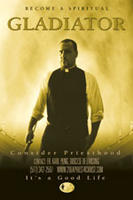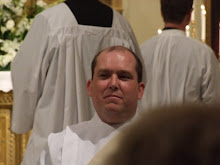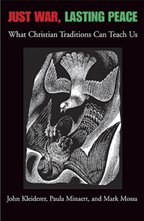Vocatio Neo Maximus


As a major movie nut, I must say I enjoy these two vocations posters. I always said that Neo's outfit looked like a Jesuit cassock. If the posters leave you wanting to know more, check out these vocation pages: New Orleans Province Jesuits, Maryland & New York Jesuits, Chicago Province Jesuits, Wisconsin Province Jesuits, Detroit Province Jesuits, Missouri Province, California Jesuits, Oregon Province Jesuits, New England Province Jesuits, and some more general information. See also the Vision religious vocation guide. And if you have questions, you can always ask me.






15 Comments:
Mark, Where did you find that Gladiator poster? It's awesome!
Amy,
Here's the address where I found it:
http://www.faithmag.com/vocations.html
from the Diocese of Lansing
Okay, I think I've officially gotten old. I wasn't terribly impressed with these posters. And though I enjoyed both the movies being referenced, I have to ask about the link between priesthood and characters whose use of brutal violence is central to their "vocation." And what is the vision of priesthood being communicated? The lone spiritual warrior? Is that going to attract men who will be capable of leading and forming communities of Christian discipleship?
I realize some "compromises" may need to be made when one is trying to attract young men. Personally, I find the example of Damien Molokai, Maximillian Kolbe, Oscar Romero, St. Francis Xavier and the like more compelling models of priesthood.
Man, I really am getting old...:-)
I have to agree, coming from the Diocese where the Matrix priest poster originated I really don't like it either. Though I do see the resemblance to the Jesuit habit now that Mark mentions it.
My biggest problem with the poster is I would much rather have a young man drawn to the image of Priest as servant than Priest as superhero.
BTW: Mark, no bias whatsover in your sending all the willing young men to Jesuit vocations sights first, right?
Maggie
I have to admit to being somewhat conflicted about such images. I'm attracted to them as a fan of movies and superheroes. But as a big proponent of nonviolence, I am sensitive to the other concerns, while also recognizing that both Saint Ignatiu and Scripture are both prone to using military images and images of battle to describe the spiritual life. So, while clearly they wont appeal to everyone, they will appeal to some. It's also worth noting perhaps that posters are one of the least effective means of promoting vocations, so they probably can't do much harm (or good, for that matter).
And, Maggie, bias?! What bias? ;)
Thanks for the comments!
Mark
I can see where Peter is coming from with the violence angle. But look at the posters. The Gladiator priest isn't holding a sword (I actually can't tell what he's holding the picture is so small.) and the Matrix Priests' weapon is ...a Rosary. That's what makes these visuals so compelling for me. The weapons for these spiritual warriors are spiritual.
I have done some reading on various priests' and seminarians' blogs where they are concerned about effeminacy spreading in the seminary. I think that the other message that these posters convey is that priests are Men, not, for lack of a better term, girly men.
I have to say I only watched the first Matrix movie, but the Neo character seems very Messianic in very Christian terms. Even in the movies, his clothes look like cassocks. It was a natural conclusion for me. And the priest functions in persona Christi.
I don't know., The visuals work for me on a lot of levels. And, really, it's time the recruitment posters, which always seem to be produced regardless of their efficacy, joined the 21st century.
In England they're using beer costers to promote vocations.
The way I see it, the posters aren't likely to "turn someone into a priest."
But they just might catch someone's attention. Someone who's had that pesky thought come up again and again and again but keeps pushing it away.
Maybe it will make them think.
God works many ways with many different people.
And I love the Matrix.
Remember ... there is no spoon.
Mark, I'd love to put a couple of questions to you about your time in formation, but I can't find an email address on your blog.
If you're up to it, drop me an email at omis_blog@yahoo.com.
I liked The Matrix, but I'd be wary of assuming that the film can be easily appropriated for Christian purposes. You might check out this review from Frederica Matthews-Greene in Christianity Today. Here's an excerpt:
"But I believe there's one big flaw in the Matrix's theology. It's the idea that the beauty of creation is a deceptive lie, generated by evil forces. Real reality, the way Neo and the others discover it, is ugly, dirty, and gray. The temptation they must resist is the desire to return to the illusory world of flowers, birdsong, and sizzling steaks. Courageous humans instead must remain resolutely in their muddy realm, wearing their dingy clothes...
It might occur to you that this actually sounds more like Hinduism than Christianity. Christians don't believe that this whole world is deceptive illusion (maya). We believe that it is created good—very good—and filled with the presence of God. "The heavens are telling the glory of God" (Ps 19:1). All creation reveals his presence. It isn't saying, "Look over there!" to keep us distracted from him."
Food for thought...:-)
I wonder about these posters as well. Perhaps we can get at this tangentially. Mark's fellow Jesuit Mark Bosco wrote an article in Commonweal about why young people were rather surprisingly drawn to Mel Gibson's 'The Passion.' I present the article not to say anything about the film (which I didn't think particularly good), but to point out something about the so-called 'Generation Y' that might show what I find missing in these posters.
Fr Bosco writes that for many of his students viewing 'The Passion' was a "spiritual experience" because of the violence. Bosco quotes Flannery O'Connor about the use of violence in her own work - it was "strangely capable of returning my characters to reality and preparing them to accept their moment of grace." Similarly, a college sophomore said of Gibson's film, "The violence tears away all other emotions you might get out of violence in our culture. It is focused on one person and there is no way it can be entertaining. If it starts out as a thrill, it quickly moves to shock, and you're left with only a terrible sense of sadness, of loss. The only thing left for you to do is to stay watching, to bear witness."
This might at first sound, well, horrible, but Bosco clarifies, "Gibson's Passion is a bloodied tragedy that has never before been so compellingly realized on film. There is little space for a postmodern, ironic gaze; instead, the viewer is asked to stand and watch," perhaps through Mary's eyes.
Can we say that, for many of those whom the posters are trying to attract, a spiritual experience is only possible with the overcoming of a "postmodern, ironic gaze"? I hasten to say that this can be done with other means than the depiction of violence, but the posters (though quite clever) only reinforce a "postmodern, ironic gaze." And, so, I don't think that they really can help one discern a vocation. Obviously, I hope that I'm wrong. And I should note that they're much better than the CSC vocations posters here at Notre Dame.
Thanks.
I think maybe you're over-analyzing what these posters are trying to accomplish. I really don't think they're trying to convey some deeper meaning in comparing priests to these movie characters, maybe at best a very surface-level comparison at people who fought for some version of "justice."
I think it's simply using a pop-cultural reference to grab someone's attention, as Susan Rose said, and maybe get a guy who's thought about vocation once to think about it some more.
Damien Molokai, Maximillian Kolbe, Oscar Romero, St. Francis Xavier are good examples for people who are further progressed in their discernment and spirituality, but these posters work as a teaser campaign.
I like Omis' take on it - the posters are like teasers. They get people talking about vocations - they got us talking about it, right? And we still screen seminary applicants, so wouldn't that screening process weed-out the ones who were not suited for priesthood?
amen, Omis and Steve.
Damien Molokai, Maximillian Kolbe, Oscar Romero, St. Francis Xavier are good examples for people who are further progressed in their discernment and spirituality...
i'll take one with maximillian kolbe on it any day :)
(i agree with this and also with chris, who came in as a late entry - posters can draw you in, but the real test is what can be done to keep you there once drawn.)
Amen, Chris. That's what's drawn me in; the holy and lived example of religious life as it is lived by real, live, human members of religious orders.
Maggie, what diocese? Indianapolis? I'm in Ft. Wayne-South Bend.
Post a Comment
<< Home